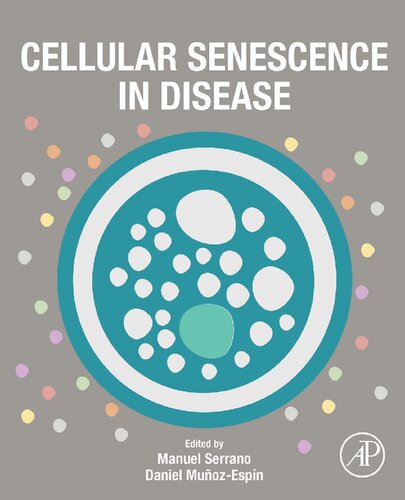Cellular Senescence in Disease 1st Edition by Manuel Serrano, Daniel Munoz Espin ISBN 9780128225141 0128225149
$50.00 Original price was: $50.00.$25.00Current price is: $25.00.
Cellular Senescence in Disease 1st Edition by Manuel Serrano, Daniel Munoz Espin – Ebook PDF Instant Download/Delivery: 9780128225141 ,0128225149
Full download Cellular Senescence in Disease 1st Edition after payment

Product details:
ISBN 10: 0128225149
ISBN 13: 9780128225141
Author: Manuel Serrano, Daniel Munoz Espin
Research in the field of senescence has boomed recently due to the gradual realization that senescent cells are associated with a significant number of diseases. The genetic or pharmacological elimination of senescent cells can cause widespread benefits and improves outcomes for most of those diseases. Cellular Senescence in Diseases presents an updated review of the role of cellular senescence in multiple pathologies. Focus is given to those diseases where the implication of senescence has been more extensively documented, such as (cancer, lung and liver diseases, diabetes, Neurodegenerative diseases and others).
The Editors recruited a group of worldwide experts in each individual pathology to review the role of cellular senescence in each one of them, aiming at identifying potential therapeutic pathways. The first two chapters provide an overview of the cellular senescence principles. Next, the chapters are divided into specific diseases. Cancer, including premalignant lesions (OIS), Advanced disease (TIS), and Metastasis are covered. The following condition covered is Lund diseases, including IPF, COPD, and Pulmonary Hypertension. Next Liver Diseases are covered, including Fibrosis and Cirrhosis, and Fatty liver disease. Next there is coverage for Kidney implications, including fibrosis and transplantation. Vascular diseases are covered next including infarction and hear fibrosis, and atherosclerosis. Both diabetes types 1 and 2 are covered next. Following chapters cover Obesity, Sarcopenia, and Bone and Cartilage disorders, respectively. Neurodegenerative diseases are covered next, focusing on Alzheimer and Parkinson. The next chapter discusses accumulation of senescent cell in tissues during aging. The two final chapters cover current developments and conclusions.
Cellular Senescence in Diseases is designed for researchers and clinicians with a focus on the cellular mechanisms of diseases. All chapters cover current experimental therapeutic approaches to eliminate or cancel the pathological effects of senescent cells. Pharmaceutical scientists may also benefit from the contents of the book in the exploration of novel therapeutic opportunities.
- 2023 PROSE Awards – Winner: Category: Biomedicine and Neuroscience: Association of American Publishers
- Provides a thorough introduction to Cellular Senescence
- Covers all major pathologies for which cellular senescence has shown evidence of involvement
- Focuses on possible therapeutic pathways
- Edited and authored by worldwide experts
Cellular Senescence in Disease 1st Edition Table of contents:
Part 1. Fundamentals
Chapter 1. Cellular senescence: from old to new testament
Old testament—genesis of senescence
New testament—from mechanisms and roles of senescence to therapies
Part 2. Cellular senescence in disease states
Chapter 2. Premalignant lesions and cellular senescence
Introduction
Cellular senescence in premalignant lesions: evidence in various organs
Future perspectives
Chapter 3. Lung aging and senescence in health and disease
Introduction
Normal lung development and aging
A brief introduction to COPD and IPF
Abnormal hallmarks of lung aging in COPD and IPF
Future treatment targeting lung senescence
Conclusions
Supported
Abbreviations
Chapter 4. Cell senescence in pulmonary hypertension
Introduction
Pulmonary hypertension, a non-aging-related proliferative vascular disorder at the crossroads of vascular disease and cancer
General considerations about aging of the systemic and pulmonary vascular systems
Considerations about constitutive cells of pulmonary vessels and the specificity of the pulmonary vasculature
Potential mechanisms accounting for cell senescence in PH and PAH
Role for senescent cells in PH and PAH
Conclusion
Chapter 5. Liver diseases fibrosis and cirrhosis
Liver structure and function
Cellular senescence
Liver diseases—epidemiology and clinical aspects
Senescence during aging of the healthy liver
Senescence in acute liver injury
Senescence in chronic liver disease
Role of senescence in hepatic dysfunction
Evolutionary role of senescence in the liver
Senescence during hepatic carcinogenesis
Summary and closing comments
Chapter 6. Cellular senescence during aging and chronic liver diseases: mechanisms and therapeutic opportunities
Introduction
Cellular senescence in the liver
Mechanisms contributing to cellular senescence in liver
Therapies: senolytic and senostatic drugs
Conclusions and outstanding questions
List of abbreviations
Chapter 7. Kidney diseases: fibrosis
Introduction
Fibrosis is a common feature of unresolved kidney damage and kidney aging
Glomerulosclerosis, vascular sclerosis, tubulointerstitial fibrosis
ECM in renal homeostasis, injury, and repair
Cellular senescence in renal aging, AKI, and CKD
Different forms and different timing of cell-cycle arrest may have detrimental or beneficial effects in AKI and CKD
TIF and cellular senescence
Senescence and the cellular origin of TIF
Senescence-associated secretory phenotype
Transforming growth factor-β (TGF-β)
WNT/β-catenin signaling
The renin-angiotensin system (RAS)
The antiaging factor Klotho
Inflammation, innate immunity, and TIF
Senescence and TIF—physiology and pathology
Chapter 8. Kidney diseases: transplantation
Introduction
Factors determining donor organ quality and their association with senescence
Impact of cellular senescence on transplant-related injuries and transplant outcome
Rejuvenating and protecting kidney transplants
Chapter 9. Vascular diseases: atherosclerosis and atherosclerotic cardiovascular diseases
Introduction—“a man is as old as his arteries”
Features of cellular senescence in vascular cells
Evidence of cellular senescence in atherosclerosis
Factors involved in vascular senescence associated with the pathophysiology of atherosclerosis
Therapeutics targeting cellular senescence for atherosclerosis
Conclusions (limitations and perspectives)
Chapter 10. Diabetes: senescence in type 1 diabetes
Introduction
Senescent beta cell accumulation as a novel pathogenic mechanism in T1D
Outstanding questions and future directions
Conclusions and outlook
Chapter 11. Senescence in obesity: causes and consequences
Introduction
Adipose tissue function in obesity
Senescent cells accumulate in multiple tissues in obesity
Causes of cellular senescence in obesity
Threshold theory of senescent cell burden
Implications of senescence in obesity: downstream effects
Strategies to target obesity-related senescent cells
Chapter 12. A framework for addressing senescent cell burden in the osteoarthritic knee: therapeutics, immune signaling, and the local-systemic interface
Introduction
Main
Conclusion
Competing interests
Chapter 13. Osteoporosis and bone loss
Osteoporosis as a public health problem
The hallmarks of aging in bone
The role of cellular senescence in mediating age-related bone loss
Estrogen deficiency and cellular senescence
The role of cellular senescence in the effects of diabetes mellitus on bone
Cellular senescence and radiation- and chemotherapy-induced bone loss
Role of cellular senescence in the growth plate and regulation by parathyroid hormone–related peptide (PTHrP)
Summary and conclusions
Chapter 14. Cellular senescence in neurodegenerative diseases
Cellular senescence: driving force or beneficial response in neurodegeneration?
Postmitotic senescence in brain aging and neurodegenerative diseases
Replicative senescence in brain aging and neurodegenerative diseases
Demyelination, oligodendrocyte lineages, and Aβ plaque propagation in AD brains
Senolytics as AD therapy
Combination therapy for AD using senolytics and senomorphics
Conclusions
Chapter 15. Cell senescence is a cause of frailty
What is frailty?
How is frailty assessed in humans?
How is frailty defined and assessed in experimental animals?
What are the possible causes of frailty?
What is cell senescence?
Does cell senescence cause frailty? How good is the evidence for it?
Conclusions
Part 3. Conclusions
Chapter 16. Senescence as a therapeutic target: current state and future challenges
Biological interpretations of cellular senescence
Tissue remodeling by senescence is a two-step process
The two steps of senescence in cancer
The two steps of senescence in disease
SASP-induced tissue repair versus SASP-induced tissue dysfunction
Molecular triggers of senescence
Triggers of senescence in vivo
The challenge of detecting cellular senescence in clinical settings
Potential side effects of eliminating senescent cells
Senolytics as an anti-aging strategy
Index
People also search for Cellular Senescence in Disease 1st Edition:
the role of cellular senescence in ageing and endocrine disease
redox changes and cellular senescence in alzheimer’s disease
cellular senescence in renal ageing and disease
cellular senescence in musculoskeletal homeostasis diseases and regeneration
cellular senescence in development regeneration and disease
Tags: Manuel Serrano, Daniel Munoz Espin, Cellular Senescence, Disease
You may also like…
Uncategorized
Biology and other natural sciences - Biology
Medicine - Immunology
Biology and other natural sciences - Molecular
Cellular and Molecular Approaches in Fish Biology 1st Edition
Uncategorized
Disease and Society in Premodern England 1st Edition by John Theilmann 1032104139 9781032104133











